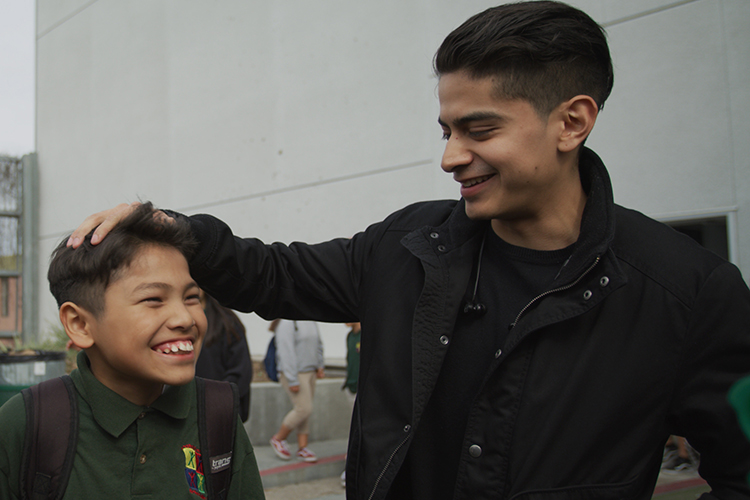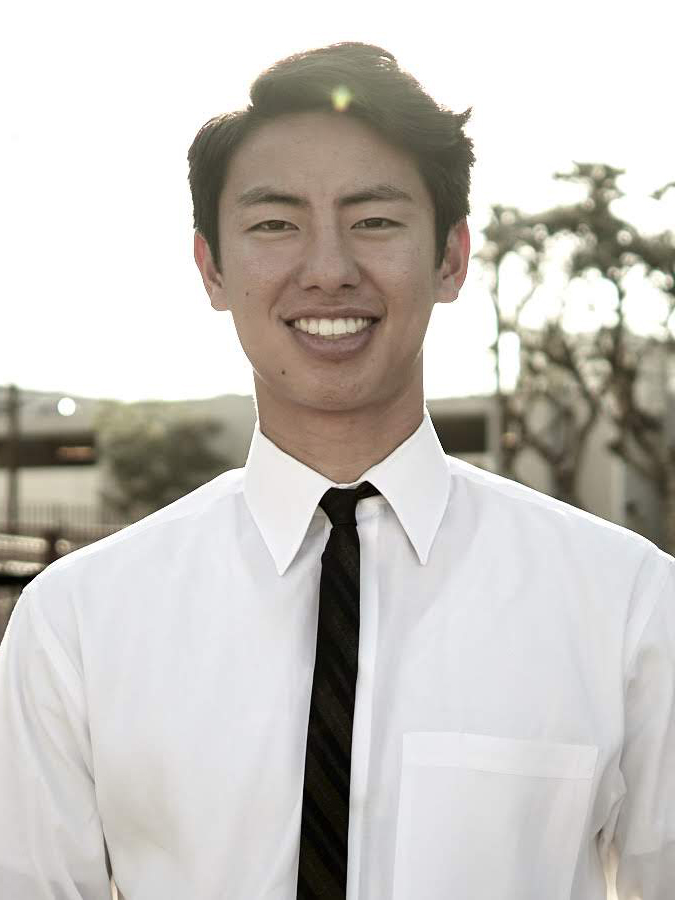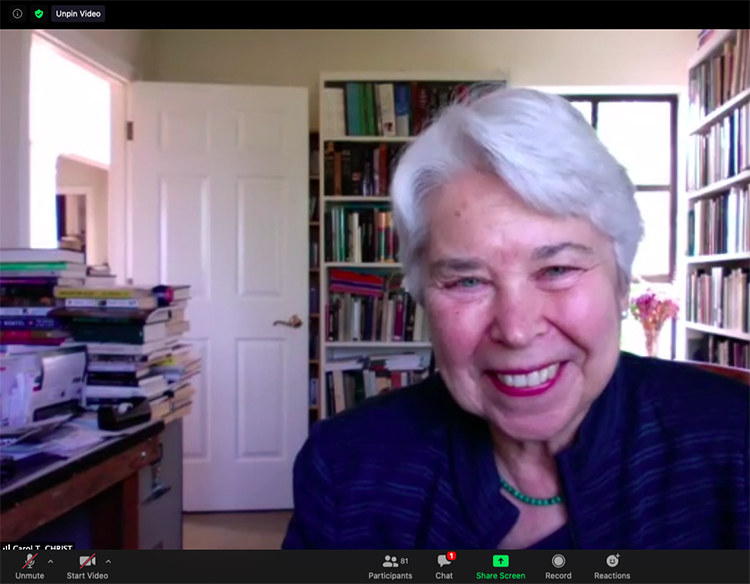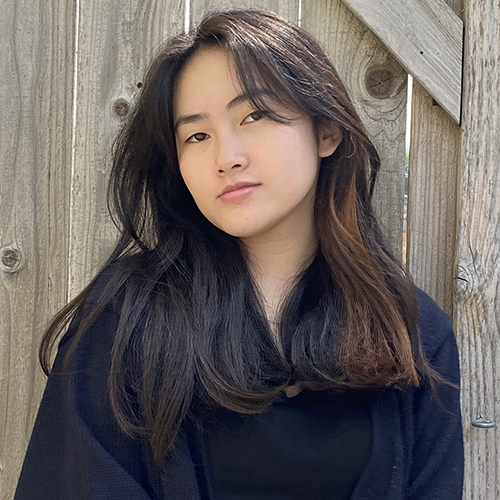Making Berkeley Home: NavCal creates community for nontraditional students
Student-created program translates 'hidden curriculum' for underrepresented students, provides a road map to succeed and give back
October 22, 2020

UC Berkeley’s NavCal program has transformed the lives of nontraditional students by helping them navigate campus and encouraging them to give back to their communities. Student Andrew Mendoza is pictured here last year in East Los Angeles with youth he has mentored. He currently mentors newly admitted Berkeley students as a NavCal mentor. (Photo courtesy of Para Los Niños)
When he transferred to UC Berkeley last fall, Andrew Mendoza was intimidated. He said the sprawling 1,200-acre campus, with its emblematic Sather Gate, abundance of vast libraries and towering Campanile looked like “something you see in a Harry Potter movie.”
But more than those iconic structures, he feared what they represented: spaces of privilege that felt foreign. Mendoza, then 24, was many of the things his fellow classmates were not — Latinx, first-generation, low-income and the first in his family to attend a four-year university.
“I just felt out of place,” said Mendoza, who came to Berkeley from Pasadena City College on a Regents’ and Chancellor’s Scholarship. “For many nontraditional students in higher education, it feels like we’re constantly pioneering in a foreign land where we don’t know the language and don’t have a legend to decipher it.”
Mendoza feared many of the things more traditional and affluent students grasp with ease: visiting with prestigious professors during office hours, confidently seeking out research opportunities and feeling like they belong on campus.
Berkeley does offer help for students like Mendoza, but he found the process of accessing that help bureaucratic and extremely overwhelming. It was hard to reconcile his personal background with the specific way he needed to carry himself into these settings on campus.

Mac Hoang pictured here in April 2019 during a NavCal student celebration at UC Berkeley’s Stiles Hall. (Photo courtesy of NavCal)
He felt pressure to be someone he was not to fit into a mold that wasn’t meant for him.
“It’s a hidden curriculum, equivalent to academic code-switching, to fit a certain norm,” Mendoza said.
But that changed when Mendoza found NavCal — short for Navigating the University of California, Berkeley — a course designed to teach nontraditional students this hidden curriculum about how to succeed at Berkeley and beyond.
NavCal was created by two Berkeleyans, Mac Hoang and Dean Tanioka, in August 2018. The pair, who were both students at the time, founded the credited class to help underrepresented students who may have grown up in the foster care system, are formerly incarcerated, low-income, first-generation, disabled or came from other nontraditional backgrounds.
“We wanted to even the playing field for students that come from our backgrounds, underrepresented students that don’t come from wealth, and get no parental guidance,” said Hoang, who graduated with a degree in Sociology in August. “We wanted to demystify the educational process and take back the opportunities that these specific student populations have been without for so long.”
The program has become more important in recent years, as Berkeley’s newly admitted classes have increasingly become more diverse.

Dean Tanioka, co-founder of UC Berkeley’s NavCal program. (Photo courtesy of NavCal)
Hoang said nontraditional students contribute to that diversity, but they also often “fall through the cracks” in their first two semesters, since they are typically older than their 18-year-old counterparts and face different personal challenges. According to an American Council on Education report, nearly 66% of nontraditional college students in the nation do not graduate.
Since its inception, NavCal has boosted the success of students who have taken the course. It’s helped more than 300 students so far find over $1 million in scholarships they otherwise might not have known about. NavCal students also hold a 3.6 average GPA.
Of the 70 students in the fall 2019 cohort, more than half landed a research position, two-thirds obtained new jobs, 68% won at least one scholarship or fellowship and 98% obtained at least one letter of recommendation by the end of the semester.
NavCal has also connected with a coalition of campus partners including the Sociology and Ethnic Studies departments, the Equity & Inclusion office, and the Centers for Educational Equity and Excellence.
“This program changed my life,” said Mendoza, who currently has a 4.0 GPA and plans to graduate in 2022 with a degree in political science. “The lessons I’ve taken from NavCal have given me the confidence to flourish in any social setting I’m presented with, and the community of students and mentors has made this 1,200-acre campus become a lot more like home for me.”
A hidden curriculum
As a student-parent, and disabled former foster youth, Hoang was initially inspired to create NavCal by his first-hand experiences navigating UC Berkeley as a Hope Scholar and member of Berkeley Underground Scholars, a group that supports students impacted by the prison system.
He found himself running up against what he called Berkeley’s “sink or swim” model, common among higher education institutions, where students are expected to thrive on their own or fail.
That often causes students to keep resources to themselves, rather than share them, to stay afloat academically, said Tanioka.
“This system is great if you have mommy and daddy to pass on generational educational knowledge,” said Hoang. “But if you are a student from lower socioeconomic standings, or a combination of first-generation and nontraditional, as many of us are, Berkeley can be overwhelming and seemingly impossible to thrive at.”
In response, Hoang and Tanioka created NavCal with the support of the Public Service Center’s Peter E. Haas Fellowship. The course was founded through a “community, not competition” model where students could help each other by sharing the experiences, resources and knowledge that help them succeed on campus: Berkeley’s hidden curriculum.
Hoang said that curriculum was inspired by Sociologist and Harvard professor Anthony Jack, author of The Privileged Poor, a book that delved into the struggles disadvantaged students have at elite colleges and how, through community, campuses can even the playing field.
“Our students don’t have to reinvent their own wheel of resources,” said Tanioka. “The students are the number one resource on campus and can disseminate what NavCal calls ‘community knowledge.’”
The class, which consists of more than 90 students, meets twice a week to discuss assigned readings and shared experiences. Hoang said students also have intimate conversations about the value of collective power, how to build high-level organizational skills, and examining their own personal indoctrinations.

Berkeley NavCal students, board members and Berkeley staff and faculty share a humorous moment during a student celebration last year. Hoang and Tanioka have created a supportive community for their students that gives them license to be themselves. (Photo courtesy of NavCal)
To create a sense of community and belonging, Hoang said each semester his students navigate Berkeley in groups with trained mentors/femtors in what NavCal calls the “Together Approach,” a way for them to transform their theories into action.
“It alleviates the students’ fears and expedites the process of resource knowledge on campus,” said Hoang.
“Many scholars can teach about the past or present inequities in education and society, but we don’t see many who are working on solutions, even in their own backyards.” Tanioka added. “Theory is just theory without actions.”
Hoang said students learn how to craft their unique life experiences into a compelling narrative to use in their academic and professional careers, creating a two-minute elevator pitch to have on hand when speaking to staff, faculty, employers, and for graduate school or scholarship interviews.
“Intentional interactions and communication skills are often overlooked and rarely taught in educational systems,” said Tanioka. “NavCal considers interactions as a priority, because there are plenty of nontraditional students who graduate from prestigious universities unemployed and lacking communications and networking skills for success in life.”

NavCal students have continued to meet virtually since remote instruction began last spring, maintaining the positive community they have built over the past two years. “NavCal is something very dear to my heart,” said American Cultures Center Director Victoria Robinson. “… If we don’t provide platforms and methods (like NavCal) to bring students in so that they can quickly get up to speed, then we’re failing our principles. (Photo courtesy of Zoom/NavCal)
This year, due to the pandemic, Berkeley’s classes are online, so the NavCal students meet on Zoom and spend extra time addressing how technology inequities — a bad internet connection at home, an old computer, lack of private space to study at home — can make it hard for students in the class to succeed. Despite being remote, the course continues to flourish with interactive virtual meetings and engaging guest speakers.
One thing that remote instruction can’t deny, for NavCal students, is their shared community.
“Students from our backgrounds have defied expectations and fought for a seat at Berkeley’s table. So, we will thrive and adapt to whatever challenges come our way,” said Hoang. “The fight for educational equity and justice does not stop because of a pandemic, nor did it start with NavCal. We stand on the shoulders of giants who have been doing this work on campus before us, such as E&I and CE3.”
Sharing the road map
Fourth-year transfer student Yanira Cortez, a mother of two, has battled depression since losing her brother in a fatal car wreck and nearly losing her own life in a boating accident that caused nerve damage, leaving her with a limp.
As a new Berkeley student in the summer of 2019, she initially had trouble balancing the demands of working full time, being a parent and taking a full course load of classes.

UC Berkeley student and NavCal mentor Yanira Cortez. (Photo courtesy of NavCal)
Cortez, 34, recalled “a moment of desperation” in an academically challenging race and law class. “I just remember sitting in the back of the classroom, full-on crying,” she said.
Talking to the professor during office hours, something other students might do automatically when they start to struggle, felt impossible. The whole experience, Cortez said, left her feeling “powerless and small.”
But Cortez found NavCal, where Hoang introduced her to faculty members in her major. Those low-stakes conversations gave her the confidence to then hold her own in discussions with her instructors.
Cortez also found Berkeley’s Disabled Students’ Program, where counselors helped devise a manageable course load for her and arranged a class schedule so that she could avoid long walks between classes.
“Growing up in my household, even if you’re disabled, culturally, you didn’t ask for help,” said Cortez, who now holds a 3.7 GPA and serves as a NavCal mentor/femtor. “I didn’t fully understand my physical limitations. I couldn’t walk all over campus with my disability. … Now, I am able to share my story and make that same difference for new students.”
Chancellor Carol Christ said she has seen the benefits NavCal has had for Berkeley students. The program recently received funds from the Chancellor’s Advisory Committee on Student Services and Fees.
“NavCal has created a welcoming community for underrepresented students at UC Berkeley and empowers those students by connecting them to the specific campus resources they need in order to thrive on campus and beyond,” said Christ. “I see programs of this type as an essential part of our efforts to build, sustain and fully support a more diverse student body.”
‘Lifting the veil’

Berkeley NavCal mentor Janae Briggs speaks at a NavCal community celebration in spring 2019. Briggs, who is lead researcher and the Nav2Cal Research Fellowship Director, told the story of how NavCal changed her Berkeley experience for the better. (Photo courtesy of NavCal)
In the last few months, NavCal has expanded its model to focus on helping nontraditional sophomore and junior high school students from West Contra Costa County navigate the University of California application process and scholarship acquisition.
Facilitated by Hoang and Tanioka, a new “Nav2Cal” course met online twice a week for two months this past summer and part of the fall. NavCal mentors joined the more than 70 high-schoolers, leading in-class discussions and sharing their experiences as nontraditional Berkeley students who, through NavCal, had already learned to navigate Berkeley successfully.
Nav2Cal is also seen as a pipeline for underrepresented and local high school students to apply and get admitted to Berkeley and to join a familiar community in NavCal upon arrival, giving those new students an opportunity to give back to other students at Berkeley.

Chancellor Carol Christ supports Nav2Cal students by giving advice to, and answering questions from, high school students during a virtual meeting this past summer. (Photo courtesy of Zoom/NavCal)
Former NavCal student Janae Briggs is lead researcher for Nav2Cal’s curriculum and mentors her own high school student cohort.
“I was just in their position a few years ago, and I know what it feels like to be uncertain about the whole college application process,” said Briggs, a Berkeley public health major. “I’m hoping to create relationships with these students, so they’ll feel like they belong at Berkeley.”
Fabrizio Mejia, assistant vice chancellor in Berkeley’s Division of Equity and Inclusion, said Nav2Cal is also an opportunity to lift the veil of exclusivity that Berkeley has had in previous years.
“For these communities that are considering applying to Berkeley, for them to know that there is something this intensive for them, I think it really does make a difference,” Mejia said. “They know that, even before they get to Berkeley, there’s going to be a community that’s in tune with their experiences and is going to be supportive of their specific needs.”

Berkeley Nav2Cal high school student Belull Yohannes. (Photo courtesy of Belull Yohannes)
Bellul Yohannes, a junior at Saint Mary’s College High School in Albany, said Berkeley always felt unobtainable. But after attending several Nav2Cal sessions this summer, she said Berkeley is now her first choice.
“I literally love this program,” said Yohannes, whose parents emigrated from East Africa and who will be the first in her family to attend college. “I just feel so inspired, because I get to see people of color at Berkeley that are pursuing what they want to do. It makes me want to work harder.”
Tanioka hopes the NavCal and Nav2Cal curricula will continue to grow and possibly expand to serve other UC schools.
The courses are not just about guiding students to excel as individuals, said Hoang, but to give back to people in the communities they come from to make Berkeley, and other institutions of higher education, places they can call home.
Pinole Valley high School junior Thao Phan said Nav2Cal has made her more confident about her chances of getting accepted, so much so that she created a club at her school to spread Nav2Cal’s curriculum to her fellow students.

Berkeley Nav2Cal high school student Thao Phan. (Photo courtesy of Thao Phan)
“I feel like the education system sometimes sets people up to just work for themselves and to keep resources from each other,” said Phan, who hopes to pursue a career in dentistry. “And I think Nav2Cal really emphasizes how much community matters and why it’s important to have a community. Those are things that I stand for.”
Now as a Nav2Cal mentor, Mendoza said, he hopes to help students validate their accomplishments and overcome the “imposter syndrome” he and many other nontraditional students experience at elite universities.
He wants to make sure they realize that Berkeley did not make a mistake.
“Through NavCal, I’ve learned that home isn’t really given to you. It’s made,” said Mendoza, who is a McNair Scholar and fellow with Harvard Kennedy School’s Public Policy Leadership Conference. “No one will ever give you the space or assistance you need unless you ask for it, and I want to impart that to younger students in my own community moving forward.”
For information on donating to NavCal visit their website here.